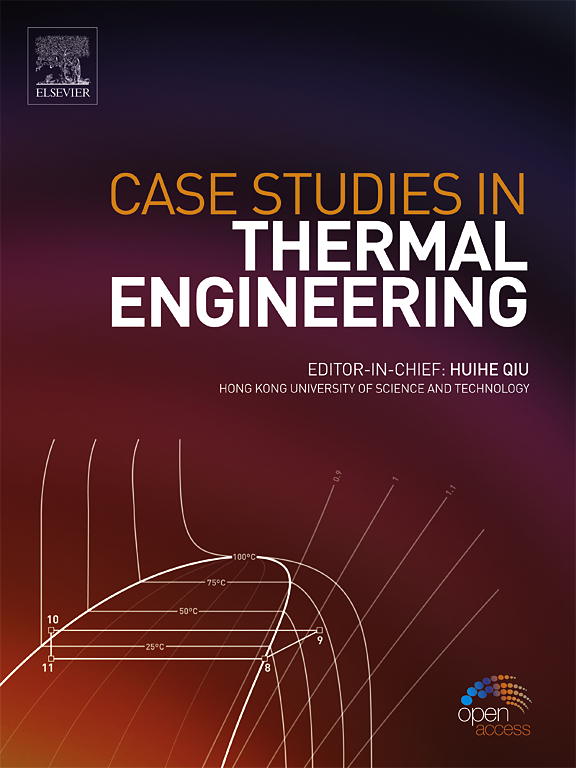Analysis of inlet temperature, pressure, and channel design effect on cryogenic methane evaporation in minichannel PCHEs
IF 6.4
2区 工程技术
Q1 THERMODYNAMICS
引用次数: 0
Abstract
The thermal-hydraulic performance of Printed Circuit Heat Exchangers (PCHEs) with minichannels plays a crucial role in liquefaction and vaporization processes within the energy sector and diverse industrial applications, serving as a pivotal component in the secure treatment of cryogenic fluids. Computational fluid dynamics (CFD) simulation was needed to do systematic analysis for the development of thermal hydraulic performance PCHEs in cryogenic applications. In this study, CFD simulations using the Volume of Fluid (VOF) method were employed to systematically investigate two-phase flow simulation in minichannel PCHEs. The effects of fluid pressure and inlet temperature on the cryogenic methane evaporation was studied, showing that lower inlet pressure and temperature increased evaporation rates. Nucleate boiling dominated at 0.1 MPa, while convective boiling occurred at higher pressures (0.7–1 MPa). Geometric analysis showed that smaller channel (D = 0.884 mm) enhanced heat transfer but caused higher pressure drops, while larger channels (D = 2–3 mm) reduced pressure losses and increased vapor generation, though with lower heat transfer coefficients. Furthermore, new zigzag channel design, based on previous research, was proposed to enhance evaporation by promoting higher turbulence, mixing, and heat transfer rates compared to straight channel. This study also reviewed the effects of various working fluids and channel geometries including channel shapes (zigzag, straight) and cross-sectional profiles (rectangular, circular, semicircular) on cryogenic evaporation performance. These results highlight how optimizing pressure, inlet temperature, and channel geometry can enhance vapor quality, heat transfer, and pressure drop performance in minichannel PCHEs for cryogenic applications.
入口温度、压力和通道设计对小通道PCHEs低温甲烷蒸发的影响分析
具有小通道的印刷电路热交换器(PCHEs)的热工性能在能源部门和各种工业应用的液化和汽化过程中起着至关重要的作用,是低温流体安全处理的关键组成部分。低温应用中热工性能的开发需要计算流体动力学(CFD)仿真进行系统分析。在本研究中,采用流体体积(VOF)方法进行CFD模拟,系统地研究了小通道PCHEs中的两相流动模拟。研究了流体压力和入口温度对甲烷低温蒸发的影响,表明入口压力和入口温度越低,蒸发速率越高。在0.1 MPa下以核沸腾为主,在0.7 ~ 1 MPa高压下以对流沸腾为主。几何分析表明,较小的通道(D = 0.884 mm)强化了换热,但导致了较大的压降;较大的通道(D = 2-3 mm)减少了压力损失,增加了蒸汽生成,但换热系数较低。此外,在前人研究的基础上,提出了新的锯齿形通道设计,通过提高湍流、混合和换热率来促进蒸发。本研究还回顾了各种工作流体和通道几何形状对低温蒸发性能的影响,包括通道形状(锯齿形、直线形)和截面形状(矩形、圆形、半圆形)。这些结果强调了如何优化压力、入口温度和通道几何形状可以提高用于低温应用的小通道PCHEs的蒸汽质量、传热和压降性能。
本文章由计算机程序翻译,如有差异,请以英文原文为准。
求助全文
约1分钟内获得全文
求助全文
来源期刊

Case Studies in Thermal Engineering
Chemical Engineering-Fluid Flow and Transfer Processes
CiteScore
8.60
自引率
11.80%
发文量
812
审稿时长
76 days
期刊介绍:
Case Studies in Thermal Engineering provides a forum for the rapid publication of short, structured Case Studies in Thermal Engineering and related Short Communications. It provides an essential compendium of case studies for researchers and practitioners in the field of thermal engineering and others who are interested in aspects of thermal engineering cases that could affect other engineering processes. The journal not only publishes new and novel case studies, but also provides a forum for the publication of high quality descriptions of classic thermal engineering problems. The scope of the journal includes case studies of thermal engineering problems in components, devices and systems using existing experimental and numerical techniques in the areas of mechanical, aerospace, chemical, medical, thermal management for electronics, heat exchangers, regeneration, solar thermal energy, thermal storage, building energy conservation, and power generation. Case studies of thermal problems in other areas will also be considered.
 求助内容:
求助内容: 应助结果提醒方式:
应助结果提醒方式:


